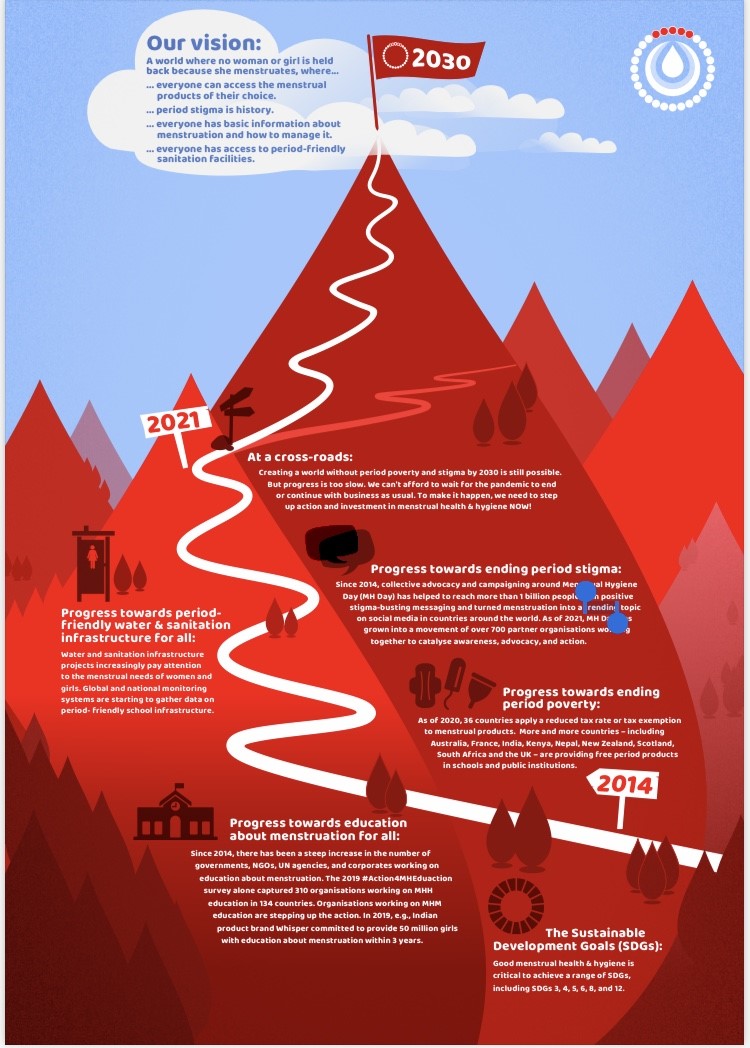By: Chelsea Carpenter
Happy Menstrual Hygiene Day! What a great opportunity to celebrate menstruation and talk about how we can care for our bodies.
Let’s make sure we’re all filled in on what Menstrual Hygiene Day is. Menstrual Hygiene Day (MHD) was started in 2013 by the German non-profit WASH United, and celebrated for the first time in 2014. It brings awareness to the lack of education about menstruation, and the resulting limitations, difficulties, and health issues this lack creates for people who menstruate all over the world.
By 2030, MHD’s goal is to create a world where no one is held back because they menstruate— a world without period stigma and period poverty. What an amazing vision!
Menstrual Hygiene Tips
As an advocate for menstrual hygiene, you can make sure you are educated about your own menstrual hygiene. You can start below with a few menstrual hygiene tips. If you have any serious concerns with your menstrual health, please talk to your doctor or gynecologist.
1. Know the Difference Between the Vulva & Vagina
Many people use the word “vagina,” when they’re really talking about the vulva, so let’s clear this up so we can talk about this better. “The vulva is the part of your genitals on the outside of your body— your labia, clitoris, vaginal opening, and the opening to the urethra (the hole you pee out of)…The vagina is a tube that connects your vulva with your cervix and uterus. Its [the tube through which] menstrual blood leave[s] the body…”
2. Don’t Wash Your Vagina, and Wash Your Vulva Carefully
Your amazing vagina is actually self-cleaning and does not need extra help. When it comes to washing your vulva, it’s recommended by gynecologists that you don’t cleanse too thoroughly. Doing so can throw off your pH balance or cause UTIs. Make sure to cleanse the vulva in the right direction. Use front to back motions, not back to front, so you avoid getting any bacteria that might be around your anus in your urethra or vagina.
3. Track Your Period
Not only will knowing when your period is coming help you be better prepared, but it will put you more in touch with your body, which is important for good menstrual hygiene. Track how long it lasts, how heavy your flow is, what color the discharge is, if there is a lot of clotting, etc. Get to know your body so you’ll know if anything changes or seems out of the ordinary.
4. Change Your Tampons, Pads, or Cups at Appropriate Intervals
Menstrual blood is a prime habitat for bacteria that already exist in our body. If allowed to grow too quickly they can get out of hand. Tampons and pads should be changed about every 4-6 hours to help regulate moisture levels and control the growth of bacteria. Menstrual cups should be emptied around every 10-12 hours at maximum, and sanitized throroughly between uses.
5. Consider NOT Shaving Your Pubic Hair
It turns out that getting rid of pubic hair isn’t as hygienic as it seems, and removing it can increase the risk of infection and irritation. A survey in 2016 showed that people who groom (especially extreme groomers who get IT ALL taken off) have a higher rate of STIs like Herpes, HPV, and Syphilis. Maybe you can opt to just keep things tidy, without removing all of it. Generally, when it comes to your public hair, less is not more.
6. Manage Your Stress
Make sure you get enough sleep and exercise to help keep stress lower. This might not seem like a “hygiene” issue, but higher levels of stress can increase chances of severe bleeding and clotting on your period, which then can become a hygiene issue.
We need to talk about menstrual hygiene more. It is time we educate ourselves on every part of our beautiful bodies. We need to do our own research, ask scary questions of our doctors, and not be afraid to talk to other womxn about our cycles. Let’s normalize discussion of this topic and make sure that by 2030 we are all well educated on menstrual hygiene, and that no one is limited or held back because they menstruate.
Sources:
- https://www.ucsf.edu/news/2016/12/405256/pubic-hair-grooming-linked-sexually-transmitted-infections
- https://menstrualhygieneday.org/about/about-mhday/
- https://women.texaschildrens.org/blog/do-you-make-any-these-7-menstrual-hygiene-mistakes
- https://blog.mylola.com/womens-health/cleanse-your-vagina/
- http://drbevanbrown.com.au/top-tips-for-menstrual-hygiene/
- https://blog.mylola.com/womens-health/pubic-hair-making-comeback-benefits/
- https://www.foreverbrazen.com/blogs/news/how-to-improve-your-cycle-for-all-people-with-periods
- https://blog.mylola.com/womens-health/deal-sweat-around-vagina/
- https://www.plannedparenthood.org/learn/health-and-wellness/sexual-and-reproductive-anatomy/what-are-parts-female-sexual-anatomy





